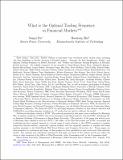| dc.contributor.author | Du, Songzi | |
| dc.contributor.author | Zhu, Haoxiang | |
| dc.date.accessioned | 2019-03-06T17:13:42Z | |
| dc.date.available | 2019-03-06T17:13:42Z | |
| dc.date.issued | 2017-01 | |
| dc.identifier.issn | 0034-6527 | |
| dc.identifier.issn | 1467-937X | |
| dc.identifier.uri | http://hdl.handle.net/1721.1/120758 | |
| dc.description.abstract | This paper studies the impact of increasing trading frequency in financial markets on allocative efficiency. We build and solve a dynamic model of sequential double auctions in which traders trade strategically with demand schedules. Trading needs are generated by time-varying private information about the asset value and private values for owning the asset, as well as quadratic inventory costs. We characterize a linear equilibrium with stationary strategies and its efficiency properties in closed form. Frequent trading (more double auctions per unit of time) allows more immediate asset reallocation after new information arrives, at the cost of a lower volume of beneficial trades in each double auction. Under stated conditions, the trading frequency that maximizes allocative efficiency coincides with the information arrival frequency for scheduled information releases, but can far exceed the information arrival frequency if new information arrives stochastically.Asimple calibration of the model suggests that a moderate market slowdown to the level of seconds or minutes per double auction can improve allocative efficiency for assets with relatively narrow investor participation and relatively infrequent news, such as small- and micro-cap stocks. | en_US |
| dc.publisher | Oxford University Press (OUP) | en_US |
| dc.relation.isversionof | http://dx.doi.org/10.1093/RESTUD/RDX006 | en_US |
| dc.rights | Creative Commons Attribution-Noncommercial-Share Alike | en_US |
| dc.rights.uri | http://creativecommons.org/licenses/by-nc-sa/4.0/ | en_US |
| dc.source | other univ website | en_US |
| dc.title | What is the Optimal Trading Frequency in Financial Markets? | en_US |
| dc.type | Article | en_US |
| dc.identifier.citation | Du, Songzi, and Haoxiang Zhu. “What Is the Optimal Trading Frequency in Financial Markets?.” The Review of Economic Studies (January 30, 2017). | en_US |
| dc.contributor.department | Massachusetts Institute of Technology. Department of Economics | en_US |
| dc.contributor.department | Massachusetts Institute of Technology. Department of Mathematics | en_US |
| dc.contributor.department | Sloan School of Management | en_US |
| dc.contributor.mitauthor | Du, Songzi | |
| dc.contributor.mitauthor | Zhu, Haoxiang | |
| dc.relation.journal | The Review of Economic Studies | en_US |
| dc.eprint.version | Author's final manuscript | en_US |
| dc.type.uri | http://purl.org/eprint/type/JournalArticle | en_US |
| eprint.status | http://purl.org/eprint/status/PeerReviewed | en_US |
| dc.date.updated | 2019-03-06T16:50:53Z | |
| dspace.orderedauthors | Du, Songzi; Zhu, Haoxiang | en_US |
| dspace.embargo.terms | N | en_US |
| dc.identifier.orcid | https://orcid.org/0000-0001-5330-3441 | |
| mit.license | OPEN_ACCESS_POLICY | en_US |
